人力资源管理 (3)
- 格式:doc
- 大小:124.00 KB
- 文档页数:23
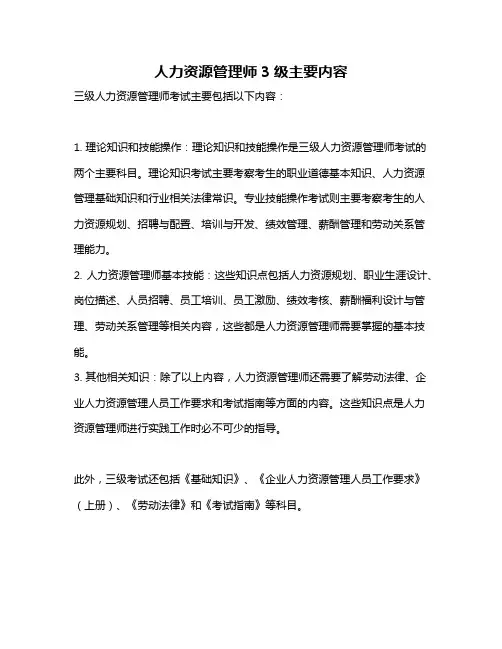
人力资源管理师3级主要内容
三级人力资源管理师考试主要包括以下内容:
1. 理论知识和技能操作:理论知识和技能操作是三级人力资源管理师考试的两个主要科目。
理论知识考试主要考察考生的职业道德基本知识、人力资源管理基础知识和行业相关法律常识。
专业技能操作考试则主要考察考生的人力资源规划、招聘与配置、培训与开发、绩效管理、薪酬管理和劳动关系管理能力。
2. 人力资源管理师基本技能:这些知识点包括人力资源规划、职业生涯设计、岗位描述、人员招聘、员工培训、员工激励、绩效考核、薪酬福利设计与管理、劳动关系管理等相关内容,这些都是人力资源管理师需要掌握的基本技能。
3. 其他相关知识:除了以上内容,人力资源管理师还需要了解劳动法律、企业人力资源管理人员工作要求和考试指南等方面的内容。
这些知识点是人力资源管理师进行实践工作时必不可少的指导。
此外,三级考试还包括《基础知识》、《企业人力资源管理人员工作要求》(上册)、《劳动法律》和《考试指南》等科目。
总的来说,三级人力资源管理师考试旨在考察考生在理论知识和专业技能操作方面的综合素质和能力水平,为从事人力资源管理工作的人才选拔和培养提供了重要的参考依据。

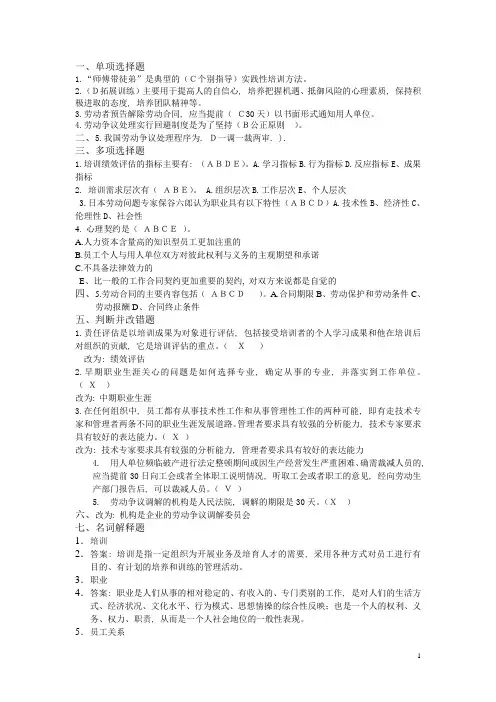
一、单项选择题1.“师傅带徒弟”是典型的(C个别指导)实践性培训方法。
2.(D拓展训练)主要用于提高人的自信心, 培养把握机遇、抵御风险的心理素质, 保持积极进取的态度, 培养团队精神等。
3.劳动者预告解除劳动合同, 应当提前(C30天)以书面形式通知用人单位。
4.劳动争议处理实行回避制度是为了坚持(B公正原则)。
二、5.我国劳动争议处理程序为. D一调一裁两审. ).三、多项选择题1.培训绩效评估的指标主要有: (ABDE)。
A.学习指标B.行为指标D.反应指标E、成果指标2. 培训需求层次有(ABE)。
A.组织层次B.工作层次E、个人层次3.日本劳动问题专家保谷六郎认为职业具有以下特性(ABCD)A.技术性B、经济性C、伦理性D、社会性4. 心理契约是(ABCE)。
A.人力资本含量高的知识型员工更加注重的B.员工个人与用人单位双方对彼此权利与义务的主观期望和承诺C.不具备法律效力的E、比一般的工作合同契约更加重要的契约, 对双方来说都是自觉的四、5.劳动合同的主要内容包括(ABCD)。
A.合同期限B、劳动保护和劳动条件C、劳动报酬D、合同终止条件五、判断并改错题1.责任评估是以培训成果为对象进行评估, 包括接受培训者的个人学习成果和他在培训后对组织的贡献, 它是培训评估的重点。
(X)改为: 绩效评估2.早期职业生涯关心的问题是如何选择专业, 确定从事的专业, 并落实到工作单位。
(X)改为: 中期职业生涯3.在任何组织中, 员工都有从事技术性工作和从事管理性工作的两种可能, 即有走技术专家和管理者两条不同的职业生涯发展道路。
管理者要求具有较强的分析能力, 技术专家要求具有较好的表达能力。
(X)改为: 技术专家要求具有较强的分析能力, 管理者要求具有较好的表达能力4. 用人单位频临破产进行法定整顿期间或因生产经营发生严重困难、确需裁减人员的,应当提前30日向工会或者全体职工说明情况, 听取工会或者职工的意见, 经向劳动生产部门报告后, 可以裁减人员。
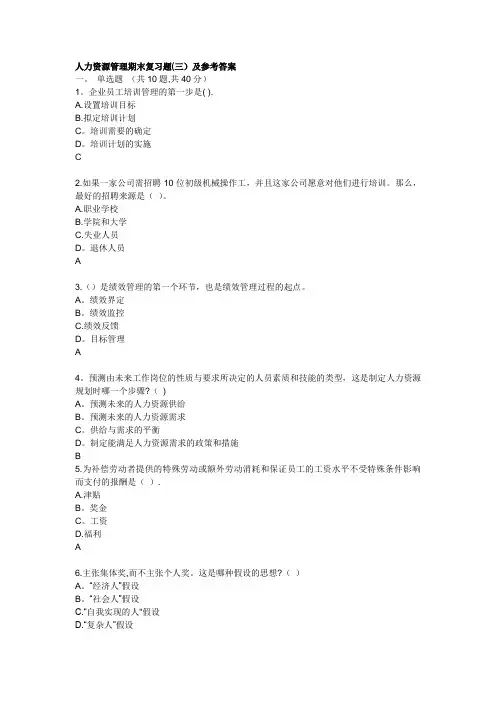
人力资源管理期末复习题(三)及参考答案一。
单选题(共10题,共40分)1。
企业员工培训管理的第一步是( ).A.设置培训目标B.拟定培训计划C。
培训需要的确定D。
培训计划的实施C2.如果一家公司需招聘10位初级机械操作工,并且这家公司愿意对他们进行培训。
那么,最好的招聘来源是()。
A.职业学校B.学院和大学C.失业人员D。
退休人员A3.()是绩效管理的第一个环节,也是绩效管理过程的起点。
A。
绩效界定B。
绩效监控C.绩效反馈D。
目标管理A4。
预测由未来工作岗位的性质与要求所决定的人员素质和技能的类型,这是制定人力资源规划时哪一个步骤?()A。
预测未来的人力资源供给B。
预测未来的人力资源需求C。
供给与需求的平衡D。
制定能满足人力资源需求的政策和措施B5.为补偿劳动者提供的特殊劳动或额外劳动消耗和保证员工的工资水平不受特殊条件影响而支付的报酬是().A.津贴B。
奖金C。
工资D.福利A6.主张集体奖,而不主张个人奖。
这是哪种假设的思想?()A。
“经济人”假设B。
“社会人”假设C.“自我实现的人"假设D.“复杂人”假设B7.劳动关系是()。
A。
用人单位与用人单位之间的关系B。
用人单位与员工之间的关系C。
用人单位内员工之间的关系D. 用人单位与外部人员之间的关系B8.通过示范,教一名工人如何操作一台车床,这是人力资源管理的哪项工作? ()A。
员工培训B.绩效考核C.人员招聘D。
职业管理A9。
将人力资源需求和内部供给的预测值加以比较以确定人员的净需求。
这是制定人力源规划时的哪一个步骤?( )A. 预测未来的人力资源供给B。
预测未来的人力资源需求C. 供给与需求的平衡D。
评估规划的有效性并进行调控和更新C10.工作分析的基本步骤是( )。
①确定工作分析的目标和侧重点,并制定总体的实施方案②收集与工作相关的背景信息③确定所欲收集的信息④与有关人员共同审核和确认工作信息⑤实施收集和分析工作信息⑥编写工作说明书和工作规范A。
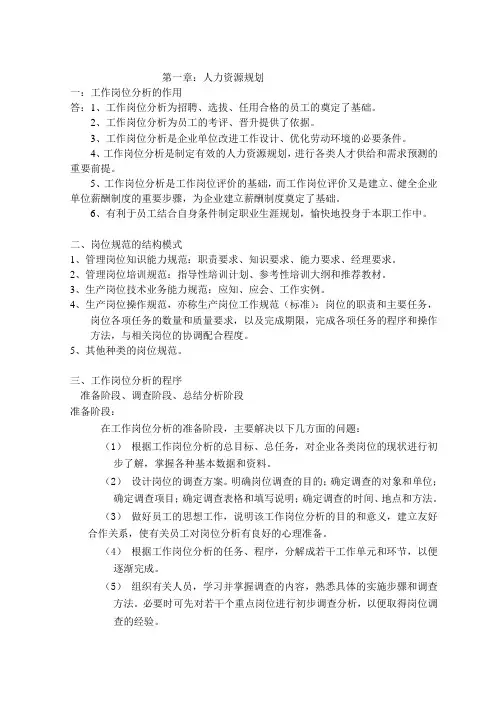
第一章:人力资源规划一:工作岗位分析的作用答:1、工作岗位分析为招聘、选拔、任用合格的员工的奠定了基础。
2、工作岗位分析为员工的考评、晋升提供了依据。
3、工作岗位分析是企业单位改进工作设计、优化劳动环境的必要条件。
4、工作岗位分析是制定有效的人力资源规划,进行各类人才供给和需求预测的重要前提。
5、工作岗位分析是工作岗位评价的基础,而工作岗位评价又是建立、健全企业单位薪酬制度的重要步骤,为企业建立薪酬制度奠定了基础。
6、有利于员工结合自身条件制定职业生涯规划,愉快地投身于本职工作中。
二、岗位规范的结构模式1、管理岗位知识能力规范:职责要求、知识要求、能力要求、经理要求。
2、管理岗位培训规范:指导性培训计划、参考性培训大纲和推荐教材。
3、生产岗位技术业务能力规范:应知、应会、工作实例。
4、生产岗位操作规范,亦称生产岗位工作规范(标准):岗位的职责和主要任务,岗位各项任务的数量和质量要求,以及完成期限,完成各项任务的程序和操作方法,与相关岗位的协调配合程度。
5、其他种类的岗位规范。
三、工作岗位分析的程序准备阶段、调查阶段、总结分析阶段准备阶段:在工作岗位分析的准备阶段,主要解决以下几方面的问题:(1)根据工作岗位分析的总目标、总任务,对企业各类岗位的现状进行初步了解,掌握各种基本数据和资料。
(2)设计岗位的调查方案。
明确岗位调查的目的;确定调查的对象和单位;确定调查项目;确定调查表格和填写说明;确定调查的时间、地点和方法。
(3)做好员工的思想工作,说明该工作岗位分析的目的和意义,建立友好合作关系,使有关员工对岗位分析有良好的心理准备。
(4)根据工作岗位分析的任务、程序,分解成若干工作单元和环节,以便逐渐完成。
(5)组织有关人员,学习并掌握调查的内容,熟悉具体的实施步骤和调查方法。
必要时可先对若干个重点岗位进行初步调查分析,以便取得岗位调查的经验。
调查阶段:主要任务是根据调查方案,对岗位进行认真细致的调查研究,灵活运用访谈、问卷、观察、小组集体讨论等方法,广泛深入地搜集有关岗位的各种数据资料。
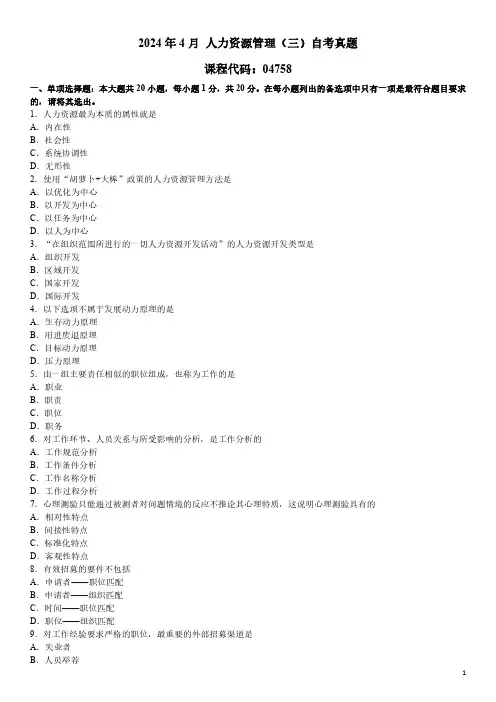
2024年4月人力资源管理(三)自考真题课程代码:04758一、单项选择题:本大题共20小题,每小题1分,共20分。
在每小题列出的备选项中只有一项是最符合题目要求的,请将其选出。
1.人力资源最为本质的属性就是A.内在性B.社会性C.系统协调性D.无形性2.使用“胡萝卜+大棒”政策的人力资源管理方法是A.以优化为中心B.以开发为中心C.以任务为中心D.以人为中心3.“在组织范围所进行的一切人力资源开发活动”的人力资源开发类型是A.组织开发B.区域开发C.国家开发D.国际开发4.以下选项不属于发展动力原理的是A.生存动力原理B.用进废退原理C.目标动力原理D.压力原理5.由一组主要责任相似的职位组成,也称为工作的是A.职业B.职责C.职位D.职务6.对工作环节、人员关系与所受影响的分析,是工作分析的A.工作规范分析B.工作条件分析C.工作名称分析D.工作过程分析7.心理测验只能通过被测者对问题情境的反应不推论其心理特质,这说明心理测验具有的A.相对性特点B.间接性特点C.标准化特点D.客观性特点8.有效招募的要件不包括A.申请者——职位匹配B.申请者——组织匹配C.时间——职位匹配D.职位——组织匹配9.对工作经验要求严格的职位,最重要的外部招募渠道是A.失业者C.竞争者D.职业介绍机构10.在工作中直接对员工进行的培训是A.在职培训B.脱产培训C.引导培训D.岗前培训11.最传统的员工培训方法是A.讲课法B.案例法C.角色扮演法D.行为模仿法12.绩效考评的关键事件法优点不包括A.排除主观因素的影响B.避免了近因效应C.避免了晕轮效应D.可为员工绩效改善提供依据13.最常见和最主要的考评主体是A.上级考评B.同事考评C.下级考评D.客户考评14.体现对职工知识积累的肯定和鼓励的是结构工资中的A.基本工资B.工龄工资C.学历工资D.岗位工资15.社会保障作为国民收入再分配的一种形式,是国家通过立法来强制实施的。
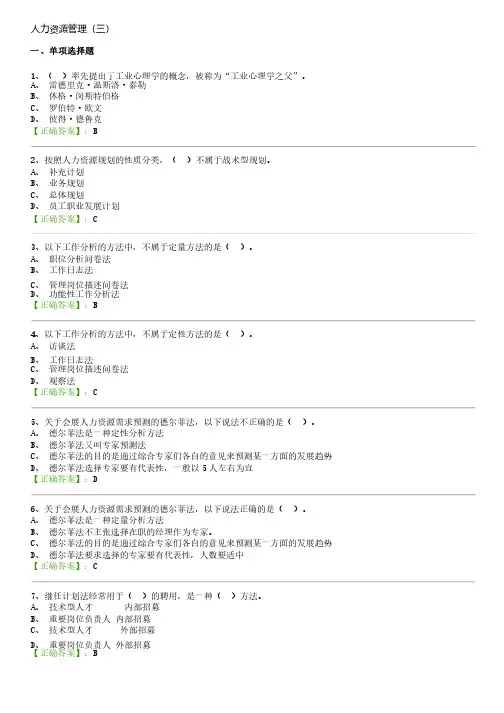
人力资源管理(三)一、单项选择题1、(、( )率先提出了工业心理学的概念,被称为“工业心理学之父”。
)率先提出了工业心理学的概念,被称为“工业心理学之父”。
A 、 雷德里克·温斯洛·泰勒雷德里克·温斯洛·泰勒 B 、 休格·闵斯特伯格休格·闵斯特伯格 C 、 罗伯特·欧文罗伯特·欧文 D 、 彼得·德鲁克彼得·德鲁克 【正确答案】:B B2、按照人力资源规划的性质分类,(、按照人力资源规划的性质分类,( )不属于战术型规划。
)不属于战术型规划。
A 、 补充计划补充计划 B 、 业务规划业务规划 C 、 总体规划总体规划 D 、 员工职业发展计划员工职业发展计划 【正确答案】:C C3、以下工作分析的方法中,不属于定量方法的是(、以下工作分析的方法中,不属于定量方法的是( )。
)。
A 、 职位分析问卷法职位分析问卷法 B 、 工作日志法工作日志法 C 、 管理岗位描述问卷法管理岗位描述问卷法 D 、 功能性工作分析法功能性工作分析法 【正确答案】:B B4、以下工作分析的方法中,不属于定性方法的是(、以下工作分析的方法中,不属于定性方法的是( )。
)。
A 、 访谈法访谈法 B 、 工作日志法工作日志法 C 、 管理岗位描述问卷法管理岗位描述问卷法 D 、 观察法观察法【正确答案】:C C5、关于会展人力资源需求预测的德尔菲法,以下说法不正确的是(、关于会展人力资源需求预测的德尔菲法,以下说法不正确的是( )。
)。
A 、 德尔菲法是一种定性分析方法德尔菲法是一种定性分析方法 B 、 德尔菲法又叫专家预测法德尔菲法又叫专家预测法 C 、 德尔菲法的目的是通过综合专家们各自的意见来预测某一方面的发展趋势德尔菲法的目的是通过综合专家们各自的意见来预测某一方面的发展趋势 D 、 德尔菲法选择专家要有代表性,一般以5人左右为宜人左右为宜 【正确答案】:D D6、关于会展人力资源需求预测的德尔菲法,以下说法正确的是(、关于会展人力资源需求预测的德尔菲法,以下说法正确的是( )。
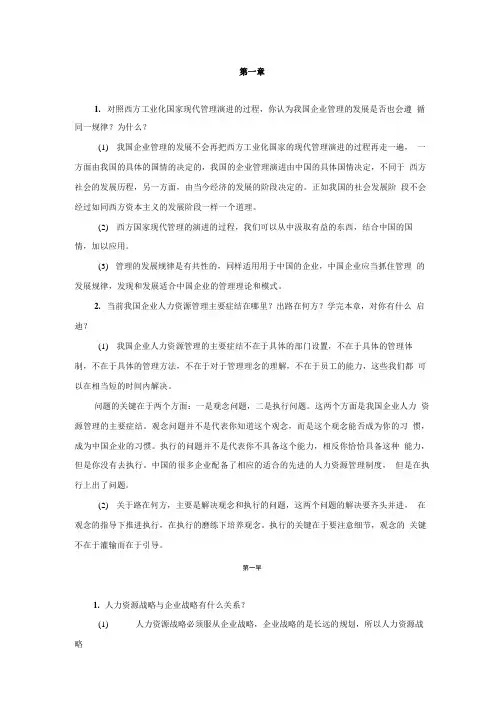
第一章1.对照西方工业化国家现代管理演进的过程,你认为我国企业管理的发展是否也会遵循同一规律?为什么?(1)我国企业管理的发展不会再把西方工业化国家的现代管理演进的过程再走一遍,一方面由我国的具体的国情的决定的,我国的企业管理演进由中国的具体国情决定,不同于西方社会的发展历程,另一方面,由当今经济的发展的阶段决定的。
正如我国的社会发展阶段不会经过如同西方资本主义的发展阶段一样一个道理。
(2)西方国家现代管理的演进的过程,我们可以从中汲取有益的东西,结合中国的国情,加以应用。
(3)管理的发展规律是有共性的,同样适用用于中国的企业,中国企业应当抓住管理的发展规律,发现和发展适合中国企业的管理理论和模式。
2.当前我国企业人力资源管理主要症结在哪里?出路在何方?学完本章,对你有什么启迪?(1)我国企业人力资源管理的主要症结不在于具体的部门设置,不在于具体的管理体制,不在于具体的管理方法,不在于对于管理理念的理解,不在于员工的能力,这些我们都可以在相当短的时间内解决。
问题的关键在于两个方面:一是观念问题,二是执行问题。
这两个方面是我国企业人力资源管理的主要症结。
观念问题并不是代表你知道这个观念,而是这个观念能否成为你的习惯,成为中国企业的习惯。
执行的问题并不是代表你不具备这个能力,相反你恰恰具备这种能力,但是你没有去执行。
中国的很多企业配备了相应的适合的先进的人力资源管理制度,但是在执行上出了问题。
(2)关于路在何方,主要是解决观念和执行的问题,这两个问题的解决要齐头并进,在观念的指导下推进执行,在执行的磨练下培养观念。
执行的关键在于要注意细节,观念的关键不在于灌输而在于引导。
第一早1.人力资源战略与企业战略有什么关系?(1)人力资源战略必须服从企业战略,企业战略的是长远的规划,所以人力资源战略必须长远规划。
(2)企业的发展战略有很多类型,所以人力资源战略必须根据不同的企业战略类型来相应的指定,而不能与企业战略背道而驰。
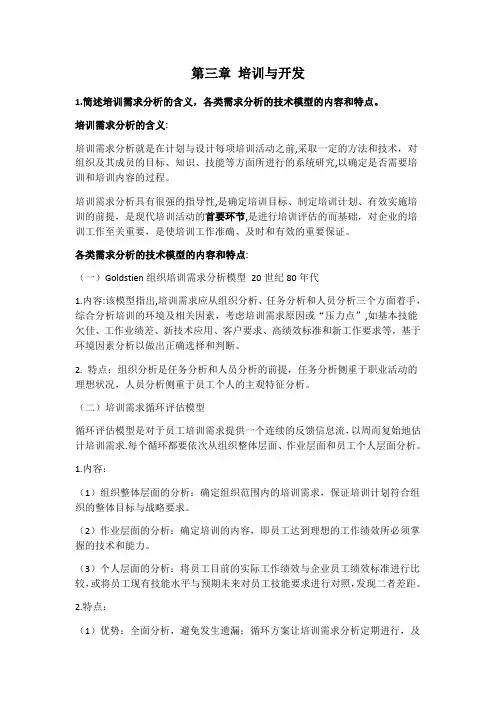
第三章培训与开发1.简述培训需求分析的含义,各类需求分析的技术模型的内容和特点。
培训需求分析的含义:培训需求分析就是在计划与设计每项培训活动之前,采取一定的方法和技术,对组织及其成员的目标、知识、技能等方面所进行的系统研究,以确定是否需要培训和培训内容的过程。
培训需求分析具有很强的指导性,是确定培训目标、制定培训计划、有效实施培训的前提,是现代培训活动的首要环节,是进行培训评估的而基础,对企业的培训工作至关重要,是使培训工作准确、及时和有效的重要保证。
各类需求分析的技术模型的内容和特点:(一)Goldstien组织培训需求分析模型20世纪80年代1.内容:该模型指出,培训需求应从组织分析、任务分析和人员分析三个方面着手,综合分析培训的环境及相关因素,考虑培训需求原因或“压力点”,如基本技能欠佳、工作业绩差、新技术应用、客户要求、高绩效标准和新工作要求等,基于环境因素分析以做出正确选择和判断。
2.特点:组织分析是任务分析和人员分析的前提,任务分析侧重于职业活动的理想状况,人员分析侧重于员工个人的主观特征分析。
(二)培训需求循环评估模型循环评估模型是对于员工培训需求提供一个连续的反馈信息流,以周而复始地估计培训需求.每个循环都要依次从组织整体层面、作业层面和员工个人层面分析。
1.内容:(1)组织整体层面的分析:确定组织范围内的培训需求,保证培训计划符合组织的整体目标与战略要求。
(2)作业层面的分析:确定培训的内容,即员工达到理想的工作绩效所必须掌握的技术和能力。
(3)个人层面的分析:将员工目前的实际工作绩效与企业员工绩效标准进行比较,或将员工现有技能水平与预期未来对员工技能要求进行对照,发现二者差距。
2.特点:(1)优势:全面分析,避免发生遗漏;循环方案让培训需求分析定期进行,及时发现需求,成为一项长期性制度;(2)不足:工作量大,需专人定期进行,也需要管理者和员工积极参与。
(三)前瞻性培训需求评估模型1.内容:为工作调动做准备、为职务晋升做准备、为适应工作内容要求的变化做准备等原因提出培训需求(预期工作技能要求)。

人力资源管理师(3级)模拟试卷二1.下列关于劳动资源稀缺性的说法错误的是() [单选题] *A.劳动资源稀缺性是相对于社会和个人的无限需要和原望而言的,是相对的稀缺性B.劳动资源稀缺性具有绝对的属性C.在市场经济中,劳动资源稀缺性的本质表现是消耗劳动资源的支付能力、支付手段的稀缺性D.劳动资源稀缺性不具普遍性(正确答案)2.揭示劳动力市场基本功能的是() [单选题] *A.收入循环模型(正确答案)B.效用最大化模型C.边际效用模型D.就业与工资模型3.劳动法的首要原则是保障劳动者的() [单选题] *A.劳动权(正确答案)B.就业权C.报酬权D.福利权4.下列不属于劳动法律关系特征的是() [单选题] *A.是劳动关系的现实形态B.内容是权利与义务C.单务关系(正确答案)D.具有国家强制性5.下列关于劳动法律关系构成要素说法错误的是() [单选题] *A.工会不是劳动法律关系主体B 工资、保险福利等属于劳动法律关系客体(正确答案)C.劳动法律行为是指以当事人的意志为转移,能够引起劳动法律关系产生、变更、消灭,具有一定法律后果的活动D.劳动法律事件是指不以当事人的主观意志为转移,能够引起一定的劳动法律后果的客观现象6.外部环境调研的方法不包括() [单选题] *A.获取口头信息B.获取书面信息C.专题性调研D.获取政策信息(正确答案)7.企业采取招标的方式让其他企业生产本企业的某种产品或者经营本企业的某种业务,指的是() [单选题] *A.特许经营B.分包(正确答案)C.卖断D.管理层与杠杆收购8.人对某种事物或特定对象所持有的一种肯定或否定的心理倾向,指的是() [单选题] *A.态度(正确答案)B.能力C.兴趣D.人格9.桑代克的强化学习法则不包括() [单选题] *A.强化原则B.惩罚原则C.消退原则D.挫败原则(正确答案)10.人的需要不包括() [单选题] *A.社会的人的需要B.企业投资者的需要C.企业全体员工的需要D.经济的需要(正确答案)11.下列关于人力资本特征,说法正确的是() [单选题] * A.人力资本具有时效性B.人力资本具有累积性C.人力资本具有个体差异性D.人力资本具有传承性(正确答案)12.下列不属于企业组织机构设置原则的是() [单选题] * A.任务目标原则B.分工协作原则C.权责对应原则D.变动性原则(正确答案)13.组织结构调查的方法不包括() [单选题] *A.观察法(正确答案)B.会议调查法C.问卷调查法D.日志调查法14. 岗位职责主要包括() [单选题] *A.职责概述和职责范围(正确答案)B.职责概述和职责结构C.职责范围和权限D.职责结构和权限15. 适用于生产比较稳定、产品品种少、生产周期短的企业的产品实耗工时统计方法是() [单选题] *A.按产品零件下逐道工序汇总产品的实耗工时(正确答案)B.按产品投入批量统计汇总产品的实耗工时C.按产品重点产品、重点零部件和主要工序统计汇总产品的实耗工时D.按生产单位和生产者个人统计汇总产品的实耗工时16. 劳动定员的对象是() [单选题] *A.劳动力B.劳动量(正确答案)C.劳动资料D.劳动17. 审核人力资源费用预算的基本要求不包括() [单选题] *A.合理性B.准确性C.科学性(正确答案)D.可比性18. 人力资源费用支出控制的原则不包括() [单选题] *A.准确性原则(正确答案)B.节约性原则C.适应性原则D.权责利相结合原则19. 人力资源费用支出控制程序是()①制定控制标准②人力资源费用支出控制③差异的处理 [单选题] *①制定控制标准②人力资源费用支出控制③差异的处理A.①②③(正确答案)B.①③②C.②①③D.②③①20. 在企业内部,最深的推荐方法是() [单选题] *A.员工推荐B.下属推荐C.主管推荐(正确答案)D.同级同事推荐21. 猎头公司的招聘对象是() [单选题] *A.高级人才(正确答案)B.基层员工C.基层技术人员D.财务人员22. 下列不属于笔试的优点的是() [单选题] *A.可以对大规模的应聘者进行甄选B.对应聘者心理压力较小C.成绩评定比较客观D.可以考查应聘者工作态度(正确答案)23. 从面试所达到的效果来看,面试可以分为() [单选题] *A.初步面试和诊断(正确答案)B.个人面试和小组面试C.结构化面试和非结构化面试D.标准化面试和非标准化面试24. “谈谈你的工作经验”,属于() [单选题] *A.封闭式提问B.清单式提问C.开放式提问(正确答案)D.确认式提问25. 无领导小组讨论的人数一般是() [单选题] *A .3-5人B .4-6人(正确答案)C.5-7人D.6-8人26. 企业劳动分工的形式不包括() [单选题] *A.职能分工B.专业(工种)分工C.技术分工D.岗位分工(正确答案)27. 企业人员配置的基本方法不包括() [单选题] *A.以人为标准进行配置B.以岗位为标准进行配置C.双向选择进行配置D.以任务为标准进行配置(正确答案)28. 企业员工培训效果评估的基础是() [单选题] *A.培训需求分析(正确答案)B.培训需求确认C.培训计划制定D.培训评估指标29. 下列关于戈德斯坦组织培训需求模型说法错误的是() [单选题] *A.培训需求分析包括组织分析、任务分析、人员分析B.人员分析是组织分析和任务分析的前提(正确答案)C.任务分析更侧重于职业活动的理想状况D.人员分析更侧重于员工个人主观特征方面的分析30. 清晰界定企业员工培训目标不包括() [单选题] *A.培训目标应解决员工培训要达到什么样标准的问题B.将培训目标具体化、数量化、指标化和标准化C.培训目标要能有效指导培训者和受训者D.培训目标必须能够实现组织战略目标(正确答案)31. 基于学习风格的课程设计不包括() [单选题] *A.主动型学习B.反思型学习C.理论型学习D.被动型学习(正确答案)32. 下列属于适宜知识类培训的直接传授的培训方法的是() [单选题] *A.讲授法(正确答案)B.工作指导法C.工作实践法D.自学33. 下列不属于培训课程实施前期准备工作的是() [单选题] *A.确认前通知参加培训的学员B.培训后勤准备C.确认培训费用(正确答案)D.确认培训时间34. 培有效性评估的作用不包括() [单选题] *A.发现新的培训需求B.控制培训成本(正确答案)C.客观评价培训者的工作D.为管理者决策提供所需信息35. 培训效果评估反应层评估的重点是() [单选题] *A.受训者的满意度(正确答案)B.知识收获C.工作中行为的改进D.受训者获得的经营业绩36. 下列不属于职业生涯规划特征的是() [单选题] *A.个性化B.预期性C.开放性D.效益性(正确答案)37. 根据绩效的内容,绩效考评指标可以分为() [单选题] *A.能力指标、态度指标、业绩指标(正确答案)B.关键绩效指标、一般绩效指标、否决指标C.定量指标、定性指标D.主观判断指标、客观考评指标38. 绩效考评标准设计的原则不包括() [单选题] *A.定性原则(正确答案)B.先进合理原则C.突出特点原则D.简明扼要原则39. 首先建立员工工作的行为特质标准,然后将达到该项标准列入评估范围内,而不在员工相互间作比较,指的是() [单选题] *A.绝对标准(正确答案)B.相对标准C.主观标准D.客观标准40. 工作态度指标设计应当选择() [单选题] *A.2-3项B.3-4项(正确答案)C.4-5项D.5-6项41. 下列主要适用于客观定量指标考核的方法是() [单选题] *A.等级赋值法B.二次赋值法C.相对赋值法D.加减赋值法(正确答案)42. 考评中某一个人格上的特征掩蔽了其他人格上的特征,指的是() [单选题] *A.个人偏见B.优先效应C.光环效应(正确答案)D.自我中心效应43. 绩效考评过程中的矛盾不包括() [单选题] *A.员工自我矛盾B.主管自我矛盾C.组织目标矛盾D.同事矛盾(正确答案)44. 回答“他这个人怎么样”属于() [单选题] *A.品质主导型考评(正确答案)B.行为主导型考评C.结果主导型考评D.主体主导型考评45. 下列属于直接薪酬的是() [单选题] *A.免费午餐B.养老保险C.职业保障D.奖金(正确答案)46. 关于薪酬管理目标,说法正确的是() [单选题] *A.吸引并留住优秀人才B.合理控制企业人工成本C.优化人才内部流动(正确答案)D.谋求员工与企业共同发展47. 下列不属于岗位评价特点的是() [单选题] *A岗位评价以岗位为评价对象B.岗位评价是对企业各类具体劳动的抽象化、定量化过程C.岗位评价需要运用多种技术和方法D.岗位评价以企业发展目标为核心(正确答案)48.下列属于不属于正式薪酬调查的是() [单选题] *A.商业性薪酬调查B.公司自己组织薪酬调查(正确答案)C.专业性薪酬调查D.政府薪酬调查49. 下列不属于专业公司薪酬数据缺点的是() [单选题] *A.代表性不强B.统计方法比较C.调查只集中在工资面上(正确答案)D.调查指标定义不统一50. 下列不属于趋势分析法的是() [单选题] *A.简单平均法B.加权平均法C.中位数法D.回归分析法(正确答案)51. 福利是一种() [单选题] *A.补充性报酬(正确答案)B.主导性报酬C.平均报酬D.市场水平报酬52. 住房公积金的缴存比例为() [单选题] *A.3%-8%B.3%-12%C.5%-8%D.5%-12%(正确答案)53. 下列关于职工代表大会制度说法正确的是() [单选题] *A.是国有企业和非国有企业民主管理的主要形式B.职工表制与民主协商只能择其一C.职工代表大会是职工民主管理的组织参与的具体体现(正确答案)D.职工代表是对企业管理的替代54. 下列不属于职工代表大会职权的是() [单选题] *A.审议建议权B.审议通过权C.审议决定权D.推荐决定权(正确答案)55. 延长工作时间每个月不得超过() [单选题] *A.12小时B.24小时C.36小时(正确答案)D.48小时56. 用人单位支付给劳动者的病假工资不得低于最低工资标准的() [单选题] *A.60%B.70%C.80%(正确答案)D.90%57. 用人单位内部劳动规则的特点不包括() [单选题] *A.制定主体特定性B.制定内容不确定性(正确答案)C.企业和劳动者共同的行为规范D.企业经营权与职工民主管理权相结合的产物58. 集体合同与劳动合同区别不包括() [单选题] *A.主体不同B.客体不同(正确答案)C.功能不同D.法律效力不同59. 下列不属于职业安全卫生保护费用的是() [单选题] *A.工伤保险费B.工伤认定费C.意外伤害保险费(正确答案)D.评残费用60. 造成3人以下死亡,或者10人以下重伤,或者1000万以下直接经济损失的事故的,属于() [单选题] *A.一般事故(正确答案)B.较大事故C.重大事故D.特别重大事故61.女性劳动参与率上升的原因包括() *A.女性受教育水平普遍提高(正确答案)B.制度劳动时间缩短(正确答案)C.人口出生率下降(正确答案)D.科技进步(正确答案)E女性斗争意识增强62. 正式解释包括() *A.法官解释B.专家解释C.立法解释(正确答案)D.司法解释(正确答案)E.行政解释(正确答案)63. 下列属于企业战略特点的有() *A.全局性(正确答案)B.系统性(正确答案)C.长远性(正确答案)D.不确定性E.搞争性(正确答案)64. 社会知觉包括() *A.首因效应(正确答案)B.光环效应(正确答案)C.投射效应(正确答案)D.对比效应(正确答案)E.刻板印象(正确答案)65. 下列属于心理特征的是() *A.能力(正确答案)B.气质(正确答案)C.性格(正确答案)D.需要E.动机66. 人力资源管理费用计划包括人力资源费用() *A.预算(正确答案)B.核算(正确答案)C.审核(正确答案)D.结算(正确答案)E.控制(正确答案)67. 工作岗位分析的信息主要来源包括() *A.书面资料(正确答案)B.任职者报告(正确答案)C.同事的报告(正确答案)D.直接观察(正确答案)E.专家报告68. 按劳动定额综合程度分,定额可以分为() *A.企业水平定额B.行业水平定额C.工序水平定额(正确答案)D.工种水平定额(正确答案)E.零件或产品的定额水平(正确答案)69. 企业统计产品的实耗工时指标的基础是() *A.原始记录(正确答案)B.访谈记录C.工时统计台账(正确答案)D.厂内报表(正确答案)E.问卷数据70. 企业劳动定员制定修订的新方法包括() *A.零基定员法(正确答案)B.概率推断法(正确答案)C.窗口服务岗位定员法(正确答案)D.回归分析定员法(正确答案)E.岗位分析定员法(正确答案)71. 下列属于人工成本项目的是() *A.工资项目(正确答案)B.保险福利项目(正确答案)C.非奖励基金的奖金(正确答案)D.招聘费用E.培训费用72. 内部招募的优点包括() *A.准确性高(正确答案)B.适应较快(正确答案)C.激励性强(正确答案)D.费用较低(正确答案)E.树立形象的作用73. 招聘广告的两个关键问题是() *A.广告模式设计B.广告内容设计(正确答案)C.广告媒体选择(正确答案)D.广告投放平台E.广告费用高低74. 提高笔试的有效性要注意的问题包括() *A.命题是否恰当(正确答案)B.确定评阅计分规则(正确答案)C.阅卷及成绩复核(正确答案)D.监考老师选择E.命题老师水平75. 下列属于能力测试的是() *A.人格测试B.兴趣测试C.普通能力倾向测试(正确答案)D.特殊职业能力测试(正确答案)E.心理运动机能测试(正确答案)76. 效度包括() *A.预测效度(正确答案)B.内容效度(正确答案)C.同测效度(正确答案)D.等值效度E.内在一致性效度77. 劳动环境优化的内容与方法包括() *A.照明与色彩(正确答案)B.噪声(正确答案)C.温度(正确答案)D.湿度(正确答案)E.绿化(正确答案)78. 下列关于培训需求循环评估模型优点的是() *A.具有稳定性B.提供了循环方案(正确答案)C.工作量小D.具有短期性E.从组织整体到员工个人全面分析培训需求,避免发生遗漏(正确答案)79. 企业员工培训与开发项目设计的原则() *A.因材施教原则(正确答案)B.实践性原则(正确答案)C.目标性原则(正确答案)D.延续性原则(正确答案)E.职业发展性原则(正确答案)80. 外部培训资源包括() *A.标准化培训产品B.专业培训公司(正确答案)C.咨询公司(正确答案)D.各级院校(正确答案)E.职业经理人81. 决定内容优先级的指导原则是() *A.根据互为依据的课题进行编排(正确答案)B.按照问题由易到难的顺序进行编排(正确答案)C.根据实用性进行编排D.根据经济性进行编排E.按照问题的出现频率、紧迫性、重要性进行编排(正确答案)82. 网上培训的优点是() *A.无须将学员从各地召集到一起,大大节省了培训费用(正确答案)B.可及时、低成本地更新培训内容(正确答案)C.提高学员的学习效率(正确答案)D.学员可以充分利用空闲时间进行(正确答案)E.体验更深刻,印象更深入83. 培训效果评估方案设计的步骤包括() *A.明确培训评估的目的(正确答案)B.培训评估方案的制定(正确答案)C.培训评估信息的收集(正确答案)D.培训评估信息的整理与分析(正确答案)E.撰写培训评估报告(正确答案)84. 绩效指标体系的设计要求包括() *A.框架性要求(正确答案)B.关键性要求(正确答案)C.完整性要求(正确答案)D.合理性要求(正确答案)E.可操作性要求(正确答案)85. 下列属于静态标准的是() *A.目标管理标准B.段式标准(正确答案)C.评语式标准(正确答案)D.量表式标准(正确答案)E.对比式标准(正确答案)86. 绩效目标设计的原则是() *A.明确具体的(正确答案)B可衡量的(正确答案)C.有行为导向的(正确答案)D.切实可行的(正确答案)E.时间和资源限制的(正确答案)87. 基于胜任特征的能力指标设计流程包括() *A.确岗位(正确答案)B.定绩效标准(正确答案)C.关键事件访谈(正确答案)D.设计能力指标(正确答案)E.证检验(正确答案)88. 企业要充分发挥下级考评的积极作用,要注意的内容包括() *A.与管理(正确答案)B.评者匿名(正确答案)C.选择考评方式D.选择考评时间E.体的考评内容(正确答案)89. 下列属于高层主管在绩效管理中的职责的是() *A.确定部门主管绩效指标(正确答案)B.绩效考评(正确答案)C.绩效反馈与面谈(正确答案)D.确定班组主管绩效指标E.效考评信息采集90. 下列属于非货币薪酬的是() *A.我发展(正确答案)B.升机会(正确答案)C.组织声誉(正确答案)D.和谐的同事关系(正确答案)E.优越的条件(正确答案)91. 下列属于影响企业员工整体薪酬水平因素的是() *A 工作条件B.工会力量(正确答案)C.产品的需求弹性(正确答案)D.劳动力市场的供求关系(正确答案)E.企业的薪酬策略(正确答案)92. 下列属于岗位评价原则的是() *A系统原则(正确答案)B实用性原则(正确答案)C.标准化原则(正确答案)D.能级对应原则(正确答案)E科学原则93. 下列属于市场薪酬调查作用的有() *A为企业调整员工的薪酬水平提供依据(正确答案)B为企业调整员工的薪酬制度奠定基础(正确答案)C有助于掌握薪酬管理的新变化与新趋势(正确答案)D有利于为企业招到一流人才E有利于控制劳动力成本,增强企业竞争力(正确答案)94. 选择薪酬调查企业包括() *A同行业中同类型的其他企业(正确答案)B其他行业中有相似相近工作岗位的企业(正确答案)C与本企业雇用同一类劳动力、可构成人力资源竞争关系的企业(正确答案) D在本地区同一劳动力市场上招聘员工的企业(正确答案)E经营策略、信誉、报酬水平和工作环境均合乎一股标准的企业(正确答案) 95. 下列属于员工法定福利的是() *A公积金(正确答案)B社会保险(正确答案)C法定假期(正确答案)D职业年金E雇主责任险96. 岗位参与的主要表现形式有() *A质量管理小组(正确答案)B班组自我管理(正确答案)C合理化建议D技术创新E 各类岗位责任制(正确答案)97. 下列属于员工满意度调查内容的是() *A薪酬(正确答案)B工作(正确答案)C人际关系D管理(正确答案)E环境(正确答案)98. 下列属于缩短工作时间对象的是() *A 人事夜班工作的职工(正确答案)B从事高山劳动的职工(正确答案)C在哺乳期的女职工(正确答案)D未成年工(正确答案)E怀孕七个月以上的女职工(正确答案)99. 确定最低工资标准一般考虑() *A失业率(正确答案)B职工平均工资(正确答案)C住房公积金(正确答案)D经济发展水平(正确答案)E社会求助水平100. 下列属于集体合同特征的是() *A意思表示一致(正确答案)B 是整体性规定劳动条件的协议(正确答案)C是定期的书面合同(正确答案)D生效需要经过特定程序(正确答案)E 工会或劳动者代表职工一方与企业签订(正确答案)。
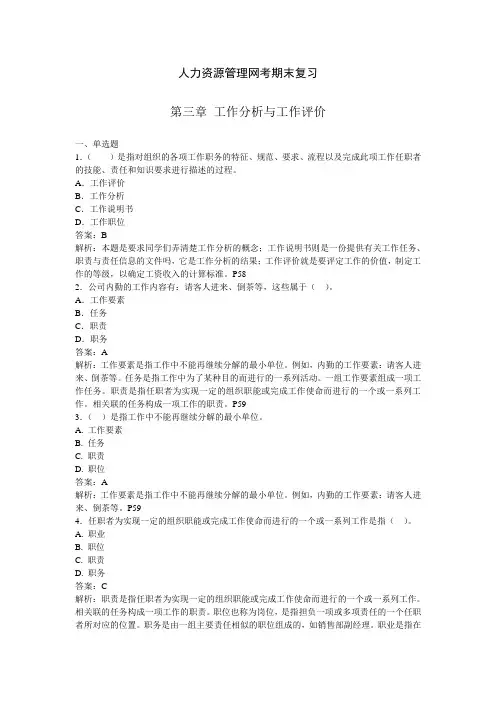
人力资源管理网考期末复习第三章工作分析与工作评价一、单选题1.()是指对组织的各项工作职务的特征、规范、要求、流程以及完成此项工作任职者的技能、责任和知识要求进行描述的过程。
A.工作评价B.工作分析C.工作说明书D.工作职位答案:B解析:本题是要求同学们弄清楚工作分析的概念;工作说明书则是一份提供有关工作任务、职责与责任信息的文件吗,它是工作分析的结果;工作评价就是要评定工作的价值,制定工作的等级,以确定工资收入的计算标准。
P582.公司内勤的工作内容有:请客人进来、倒茶等,这些属于()。
A.工作要素B.任务C.职责D.职务答案:A解析:工作要素是指工作中不能再继续分解的最小单位。
例如,内勤的工作要素:请客人进来、倒茶等。
任务是指工作中为了某种目的而进行的一系列活动。
一组工作要素组成一项工作任务。
职责是指任职者为实现一定的组织职能或完成工作使命而进行的一个或一系列工作。
相关联的任务构成一项工作的职责。
P593.()是指工作中不能再继续分解的最小单位。
A. 工作要素B. 任务C. 职责D. 职位答案:A解析:工作要素是指工作中不能再继续分解的最小单位。
例如,内勤的工作要素:请客人进来、倒茶等。
P594.任职者为实现一定的组织职能或完成工作使命而进行的一个或一系列工作是指()。
A. 职业B. 职位C. 职责D. 职务答案:C解析:职责是指任职者为实现一定的组织职能或完成工作使命而进行的一个或一系列工作。
相关联的任务构成一项工作的职责。
职位也称为岗位,是指担负一项或多项责任的一个任职者所对应的位置。
职务是由一组主要责任相似的职位组成的,如销售部副经理。
职业是指在不同的组织中从事相似活动的一系列职务。
P595.工作性质完全相同的职位系列称作()。
A. 职级B. 职等C. 职组D. 职系答案:D解析:职系是指一些工作性质相同,而责任轻重和困难程度不同的工作。
职组也称职群,是指工作性质相近的若干职系的总和。
《人力资源管理(三)》复习资料一、单项选择题1.()创建了最早的工作绩效评价体系,被称为“人事管理之父”。
A.雷德里克·温斯洛·泰勒B.休格·闵斯特伯格C.罗伯特·欧文D.彼得·德鲁克正确答案:C答案解析:最早“播下人事管理种子”的人是罗伯特·欧文(Robert Owen,1771-1858),他是英国卓越的空想社会主义者,也是19世纪初最有成就的实业家之一,杰出的管理先驱。
他认为,好的环境使人形成良好的品行,坏的环境则使人形成不好的品行。
他在苏格兰自己的几个纺织厂内进行了空前的试验,致力于人性化的管理,创建了最早的工作绩效评价体系,被称为“人事管理之父”。
参见教材P22.()是科学管理的接触代表,被称为“科学管理之父”。
A.雷德里克·温斯洛·泰勒B.休格·闵斯特伯格C.罗伯特·欧文D.彼得·德鲁克正确答案:A答案解析:美国机械工程师弗雷德里克·温斯洛·泰勒(Fredrick Winslow Taylor,1856-1915,又译作泰罗)。
他是科学管理的杰出代表,被誉为科学管理之父。
参见教材P23.()率先提出了工业心理学的概念,被称为“工业心理学之父”。
A.雷德里克·温斯洛·泰勒B.休格·闵斯特伯格C.罗伯特·欧文D.彼得·德鲁克正确答案:B答案解析:工业心理学方面最重要的代表是休格·闵斯特伯格(Hugo Munsterberg,1863-1916)和乔治·埃尔顿·梅奥(George Elton Mayo,1880-1949)。
前者在《心理学与工业效率》中率先提出了工业心理学的概念。
参见教材P24.按照人力资源规划的性质分类,()不属于战术型规划。
A.补充计划B.业务规划C.总体规划D.员工职业发展计划正确答案:C答案解析:战术性人力资源规划则是短期的业务人力资源规划,主要包括人员补充计划、分配计划、提升计划、教育培训计划、工资计划、保险福利计划、劳动关系计划、退休计划等。
企业人力资源管理师(3级)复习题1. Ed>1指的是() [单选题] *A劳动力供给富有弹性B劳动力供给缺乏弹性C劳动力需求富有弹性(正确答案)D劳动力需求缺乏弹性2. 人本管理认为,企业为人的需要而存在,其中“人的需要”不包括()。
[单选题] * A社会的人的需要B市场消费者的需要(正确答案)C企业全体员工的需要D企业投资者的需要3. 下列不属于缩短工作时间对象的是() [单选题] *A从事夜班工作的职工B哺乳期工作的女职工C残疾工人(正确答案)D未成年工4. 企业管理体制中的“制”指的是() [单选题] *A企业组织的无形部分(正确答案)B中层管理者之间的关系C不同管理单元的沟通D决策层对企业的控制力5. 下列关于岗位规范与工作说明书的关系,说法正确的是() [单选题] * A岗位规范就是工作说明书B两者主题相同C工作说明书是岗位规范的表现形式D工作说明书结构要比岗位规范多样化(正确答案)6. ()是职工通过个人行为参与企业管理的形式之一 [单选题] *A质量管理小组B 合理化建议(正确答案)C班组自我管理D各类岗位责任制7. 诚信的基本特征是() [单选题] *A通识性、智慧性、止损性、资质性(正确答案)B双向性、对等性、资质性、惩罚性C社会性、共识性、双向性、对等性D单向性、前置性、智慧性、要约性8. 按照职业道德要求职业化是指从业人员工作状况的() [单选题] *A 标准化、规范化、制度化(正确答案)B 全球化、现代化、市场化C一致化、动作化、简约化D高效化、人性化、科学化9. 岗位评价的直接信息来源,其特点不包括()。
[单选题] *A真实B详细全面C可靠D省时省力(正确答案)10. 工作的数量与质量,出勤率等属于() [单选题] *A等级标准B比值标准(正确答案)C隶属度标准D类别标准11. 组织整体层面的培训需求分析关键要()。
[单选题] *A发现组织目标和培训需求之间的联系(正确答案)B组织高层的重视和投入C对组织外部环境和内部氛围进行分析D确认整体是否需要培训12. 某公司奉行”不惜一切为顾客服务”的理念,正确理解的是() [单选题] * A要不计成本地满足顾客的要求B无条件地满足顾客提出的任何要求C 一切都是顾客说了算D顾客的满意程度决定企业的命运(正确答案)13. 个人职业生涯规划对企业的意义包括() [单选题] *A平衡个人、事业、家庭关系B发现新的职业机遇C促进个人目标与组织目标统一(正确答案)D增强职业竞争力14. 下列属于外部招募优点的是() [单选题] *A费用低B 进入角色快C可以招聘到一流人才(正确答案)D激励性强15. 在职工代表大会的代表中各级管理人员一般为代表总数的()。
华南师范大学《人力资源管理》考试题库(3)及满分答案内容摘要:员工培训的根本目的在于促进员工学习能力的培养和加强,共同满足组织发展战略的需要和满足员工个体发展的需要。
标准答案:1职业发展规划的核心内容是职业发展路径的选择、进入和变化。
标准答案:1绩效管理是管理者和团队、成员共同提高绩效、获得绩效的过程。
标准答案:1劳动能力是工作行为的核心要...员工培训的根本目的在于促进员工学习能力的培养和加强,共同满足组织发展战略的需要和满足员工个体发展的需要。
标准答案:1职业发展规划的核心内容是职业发展路径的选择、进入和变化。
标准答案:1绩效管理是管理者和团队、成员共同提高绩效、获得绩效的过程。
标准答案:1劳动能力是工作行为的核心要素。
标准答案:1绩效考评的核心是促进组织效率和效益的提高以及增强组织综合实力。
标准答案:1人力资源开发管理与传统劳动人事管理不是简单措辞上的变化,而是思想、实质、内涵上的变化。
标准答案:1组织文化的约束功能告诉我们,规章制度是基础。
组织文化的约束功能就是通过规章制度的刚性作用实现的。
标准答案:0组织文化的导向功能在于把组织成员统一到组织所确定的共同目标和使命上来。
标准答案:1任何组织文化建设都必然会打上组织文化创始者的烙印。
标准答案:1员工归属感不仅直接来源于组织对员工需求的满足和保护,更源于员工对组织目标及其价值观念的尊崇和接受。
标准答案:1代理理论指出,代理人利益与委托人利益一致的行为导向型契约以佣金制为代表,其代理成本是显性的。
标准答案:0绩效管理的目的就是持续提升个人、部门和组织的绩效。
标准答案:1绩效考评工作的最后必包含对考评结果的反馈和运用环节。
标准答案:1影响工作满意感的最根本因素是个体人员客观存在的各种需求和价值观念。
标准答案:1组织薪酬设计要与组织生命周期所处的阶段相适应,因此,每个不同时期组织的薪酬设计侧重点是不同的。
标准答案:1岗位工作评价的关键在于确定组织内岗位的相对关系,即解决好组织内部各岗位之间的相对关系。
人力资源管理3级人力资源管理是现今企业存在的一种重要的管理工作,它的作用主要是把企业内部的人才和资源进行科学有效的管理,以达到企业的经营目的。
随着市场经济的发展,管理者越来越重视人力资源管理的重要性,人力资源管理已经发展为一个大型管理体系,形成了一套完整的管理体系。
人力资源管理主要有三个层次:第一,战略性人力资源管理。
这是企业总体发展战略的一部分,它要求企业经营者从总体的角度,规划企业的发展方向,根据发展方向,实施有效的人力资源管理政策、抓取人力资源的配置,满足企业发展需要,把人力资源投入到最佳的位置,以促进企业发展。
第二,经营性人力资源管理。
这是企业正常经营时实施的人力资源管理,其目的是满足企业正常运营所需要的人力资源,从而保证企业的正常生产经营,确保企业正常经营。
它要求企业经营者采取有效的人力资源管理政策,通过有效的组织管理,使人力资源得到有效的运用和配置,从而为企业发展打下基础。
第三,经济性人力资源管理。
这是企业在改善内部经济效益时,采取的管理措施。
它既要保证企业的运营正常,也要提高内部的经济效益,其目的是在有限的资源内部,尽可能地把人力资源配置到增加企业经济收益的地方,做到最大化企业经济效益。
人力资源管理是企业经营有效运作的重要保障,也是非常重要的经营管理工作。
因此,企业应该重视人力资源管理,从战略层面全面进行人力资源管理,使企业可以得到长远的发展和良好的经营绩效。
首先,要认识到人力资源管理的重要性并制定一套完整的管理体系。
企业的成败,首先要看人,管理者需要有一个明确的战略思想,根据战略需要,把人力资源进行有效的配置,确保企业发展取得良好的结果。
同时,还要把经营管理的基本原则纳入到管理体系中,以最大限度地发挥其作用。
其次,要实施有效的人力资源管理措施。
管理者应实施有效的招聘、选择、培训、聘用、考核和激励措施,从而有效地把人力资源转换成更高的经济效益。
同时,管理者要注重培养企业员工的素质,以保证人力资源的高效运用,最大限度地提高企业的经济效益。
True/False Questions1. The way in which a firm competes has little relationship to the way it is structured andhow work tasks are organized.Answer: False Page: 144 LO: 1 Difficulty: EasyAACSB: 6 BT: Comprehension2. Workflow design is the process of analyzing the tasks necessary for the production of aproduct or service.Answer: True Page: 145 LO: 1 Difficulty: EasyAACSB: 6 BT: Knowledge3. Work-flow design refers to the relatively stable and formal network of vertical andhorizontal interconnections among jobs that constitute the organization.Answer: False Page: 145 LO: 1 Difficulty: MediumAACSB: 6 BT: Knowledge4. The final stage in the work-flow analysis is to identify the inputs used in thedevelopm ent of the work unit’s product.Answer: True Page: 148 LO: 1 Difficulty: EasyAACSB: 6 BT: Knowledge5. Centralization refers to the degree to which work units are grouped based on functionalsimilarity or similarity of work flow.Answer: False Page: 150 LO: 1 Difficulty: MediumAACSB: 6 BT: Knowledge6. Functional structures tend to be less flexible, but more innovative than divisionalstructures.Answer: False Page: 152 LO: 1 Difficulty: MediumAACSB: 6 BT: Knowledge7. Divisional structures are most appropriate in stable, predictable environments where itis relatively easy to anticipate demands for resources and coordination requirements between jobs that are not consistent over time.Answer: False Page: 153 LO: 1 Difficulty: MediumAACSB: 6, 13 BT: Comprehension8. Job analysis refers to the process of getting detailed information about jobs.Answer: True Page: 158 LO: 2 Difficulty: EasyAACSB: 6 BT: Knowledge9. Job evaluation is a performance appraisal that deals with getting information about howell each employee is performing.Answer: False Page: 159 LO: 2 Difficulty: MediumAACSB: 6 BT: Knowledge10. A job description is a list of the knowledge, skills, abilities, and other characteristics thatan individual must have to perform the job.Answer: False Page: 159 LO: 2 Difficulty: EasyAACSB: 6 BT: Knowledge11. KSAOs are characteristics about people that are not directly observable, but that can beidentified when individuals are carrying out the TDRs of the job.Answer: True Page: 160 LO: 2 Difficulty: MediumAACSB: 6 BT: Knowledge12. Research has shown that there is greater agreement between supervisors andsubordinates when rating general job duties than when rating specific tasks.Answer: True Page: 160 LO: 2 Difficulty: MediumAACSB: 6 BT: Knowledge13. Research has demonstrated that high performers give more accurate job analysisinformation than do low job performers.Answer: False Page: 160 LO: 2 Difficulty: MediumAACSB: 6 BT: Knowledge14. Job context is not part of the Position Analysis Questionnaire (PAQ).Answer: False Page: 160 LO: 3 Difficulty: MediumAACSB: 6 BT: Knowledge15. A disadvantage of the Position Analysis Questionnaire is that it requires employees tohave a college reading level.Answer: True Page: 162 LO: 3 Difficulty: MediumAACSB: 6 BT: Knowledge16. The Fleishman Job Analysis System provides an accurate picture of the abilityrequirements of a job.Answer: True Page: 163 LO: 3 Difficulty: MediumAACSB: 6 BT: Knowledge17. The Position Analysis Questionnaire is based on a taxonomy of 52 cognitive,psychomotor, physical, and sensory abilities.Answer: False Page: 163 LO: 3 Difficulty: MediumAACSB: 6 BT: Knowledge18. Due to technological changes in the nature of work, global competition, and a shift fromstable, fixed manufacturing jobs to a more flexible, dynamic service-based economy, the Dictionary of Occupational Titles has been replaced by O*NET, the Occupational Information Network.Answer: True Page: 164 LO: 4 Difficulty: EasyAACSB: 6 BT: Knowledge19. Unlike the Dictionary of Occupational Titles, which described approximately 1,000occupations, O*NET lists some 12,000 jobs.Answer: False Page: 164 LO: 4 Difficulty: EasyAACSB: 6 BT: Knowledge20. Although we tend to view jobs as changing and evolving over time, jobs are static andstable.Answer: False Page: 165 LO: 4 Difficulty: MediumAACSB: 6 BT: Knowledge21. Job design is the process of defining the way work will be performed and the tasks thatwill be required in a given job.Answer: True Page: 166 LO: 5 Difficulty: EasyAACSB: 6 BT: Knowledge22. The mechanistic approach to job design has its roots in classical engineering.Answer: True Page: 167 LO: 5 Difficulty: EasyAACSB: 6 BT: Knowledge23. The motivational approach emerged as a reaction to mechanistic approaches to jobdesign.Answer: True Page: 167 LO: 5 Difficulty: EasyAACSB: 6 BT: Knowledge24. Job design interventions emphasizing the motivational approach tend to focus onincreasing the autonomy of jobs.Answer: False Page: 168 LO: 5 Difficulty: MediumAACSB: 6 BT: Knowledge25. Whereas the biological approach to job design focuses on physical capabilities andlimitations, the perceptual-motor approach focuses on human mental capabilities and limitations.Answer: True Page: 170-171 LO: 5 Difficulty: EasyAACSB: 6 BT: Comprehension26. The choice of various job design approaches depends on the trade-off between theeffectiveness of jobs and the efficiency with which the jobs are performed.Answer: False Page: 173 LO: 6 Difficulty: MediumAACSB: 6 BT: Knowledge27. Jobs redesigned to increase their motivating potential result in higher costs in terms ofability requirements, training, and compensation.Answer: True Page: 173 LO: 6 Difficulty: MediumAACSB: 6 BT: KnowledgeMultiple Choice Questions28. An organization needs to create a fit between its organizational design and all of thefollowing exceptA) its environmentB) its products and servicesC) philosophyD) competitive strategyAnswer: B Page: 144 LO: 1 Difficulty: MediumAACSB: 6 BT: Knowledge29. Which of the following statements is true regarding job design and job analysis?A) job design and job analysis have extensive overlapB) job analysis has had a more proactive orientationC) job design has had a passive orientationD) job design focuses on analyzing existing jobs to gather informationAnswer: A Page: 145 LO: 1 Difficulty: MediumAACSB: 6 BT: Comprehension30. Which of the following refers to the process of analyzing the tasks necessary for theproduction of a product or service prior to allocating and assigning the tasks toparticular job category or person?A) Job designB) Job analysisC) Job evaluationD) Workflow designAnswer: D Page: 145 LO: 1 Difficulty: EasyAACSB: 6 BT: Knowledge31. _____ focuses on analyzing existing jobs to gather information for other humanresource management practices, whereas _____ focuses on redesigning existing jobs to make them more efficient or more motivating to jobholders.A) Job analysis; job designB) Job design; job analysisC) Job evaluation; workflow designD) Workflow design; job evaluationAnswer: A Page: 145 LO: 1 Difficulty: EasyAACSB: 6 BT: Knowledge32. The ProMES system is most relevant to what part of workflow analysis?A) Analyzing work outputsB) Analyzing work processesC) Analyzing work inputsD) Analyzing work relationshipsAnswer: A Page: 147 LO: 1 Difficulty: MediumAACSB: 6 BT: Comprehension33. The _____ are the activities that members of a work unit engage in to produce a givenoutput.A) work outputsB) work analysesC) work inputsD) work processesAnswer: D Page: 148 LO: 1 Difficulty: MediumAACSB: 6 BT: Knowledge34. The final stage of a workflow analysis is analyzing theA) work outputs.B) work inputs.C) work processes.D) work relationships.Answer: B Page: 148 LO: 1 Difficulty: MediumAACSB: 6 BT: Knowledge35. Assume that you are writing a report for your class. You do not possess good writingskills, and because of this deficiency, your paper receives a grade of D. In which part of the workflow process was the deficiency?A) Raw material inputsB) EquipmentC) Human skillsD) ActivityAnswer: C Page: 148 LO: 1 Difficulty: HardAACSB: 6 BT: Application36. Research has shown that creating a good fit between the skills and values of employeesand _______ is a powerful determinate of organizational success.A) the environment in which they workB) their co-workersC) the culture of the departmentD) the tasks and mission they are assignedAnswer: D Page: 150 LO: 1 Difficulty: MediumAACSB: 6 BT: Comprehension37. When decision-making authority resides at the top of the organizational chart asopposed to being distributed throughout lower levels, an organization isA) divisional.B) mechanistic.C) centralized.D) decentralized.Answer: C Page: 150 LO: 1 Difficulty: EasyAACSB: 6 BT: Knowledge38. What kind of a structure combines a work-flow departmentalization scheme withrelatively low levels of centralization?A) Mechanistic structureB) Divisional structureC) Functional structureD) Centralized structureAnswer: B Page: 153 LO: 1 Difficulty: MediumAACSB: 6 BT: Knowledge39. Divisional structures are most appropriateA) when flexibility is required.B) when dealing with rapidly changing environments.C) in support of organizations that compete on differentiation.D) all of the above.Answer: D Page: 154 LO: 1 Difficulty: MediumAACSB: 6 BT: Comprehension40. Self-cannibalization is a concern of which one of the following structures?A) FunctionalB) DivisionalC) Project-basedD) Team-basedAnswer: B Page: 155 LO: 1 Difficulty: EasyAACSB: 6 BT: Comprehension41. Which of the following is not a job analysis method important to HR managers?A) RedesignB) SelectionC) Performance appraisalD) TrainingAnswer: A Page: 158 LO: 2 Difficulty: EasyAACSB: 6 BT: Knowledge42. Identifying the most qualified applicants for employment refers toA) career planning.B) human resource planning.C) training.D) selection.Answer: D Page: 158 LO: 2 Difficulty: MediumAACSB: 6 BT: Knowledge43. When job analysis information is used to judge the relative dollar value of each jobwithin an organization, this HR activity is termedA) performance evaluations.B) training and development.C) job evaluation.D) work redesign.Answer: C Page: 159 LO: 2 Difficulty: MediumAACSB: 6 BT: Knowledge44. Which of the following is not a managerial benefit of job analysis?A) It provides managers with an understanding of the workflow processB) It enables managers to make more accurate hiring decisionsC) It provides an avenue for communicating policy information to employeesD) It enables managers to more accurately evaluate subordinates' performanceAnswer: C Page: 159 LO: 2 Difficulty: MediumAACSB: 6 BT: Comprehension45. Which of the following refers to a list of the tasks, duties, and responsibilities that a jobentails?A) Job specificationB) Job descriptionC) Job analysisD) Job designAnswer: B Page: 159 LO: 2 Difficulty: EasyAACSB: 6 BT: Knowledge46. Which of the following refers to the knowledge, skills, abilities, and othercharacteristics that an individual must have to perform the job?A) Job specificationB) Job descriptionC) Job analysisD) Job designAnswer: A Page: 160 LO: 2 Difficulty: EasyAACSB: 6 BT: Knowledge47. A person's factual or procedural information that is necessary for successfullyperforming a task is calledA) knowledge.B) ability.C) skill.D) responsibility.Answer: C Page: 160 LO: 2 Difficulty: MediumAACSB: 6 BT: Knowledge48. Job descriptions generally contain all but one of the following components. Name theexception.A) Job titleB) Essential dutiesC) Percentage of time spent on dutiesD) Pay levelAnswer: D Page: 160 LO: 2 Difficulty: MediumAACSB: 6 BT: Knowledge49. Job analysis information usually is obtained fromA) coworkers and customers.B) job incumbents and coworkersC) customers and supervisors.D) job incumbents and supervisors.Answer: D Page: 161 LO: 2 Difficulty: MediumAACSB: 6 BT: Knowledge50. Which of the following sources of job analysis information would most likely provideaccurate information regarding the time spent on various tasks?A) SupervisorsB) IncumbentsC) CustomersD) SubordinatesAnswer: B Page: 161 LO: 2 Difficulty: HardAACSB: 6 BT: Comprehension51. Which of the following sources of job analysis information would be the most likely toprovide accurate information regarding the importance of various tasks?A) SupervisorsB) IncumbentsC) CustomersD) SubordinatesAnswer: A Page: 161 LO: 2 Difficulty: MediumAACSB: 6 BT: Comprehension52. Which of the following is not one of the methods for analyzing jobs in use today?A) Position Analysis QuestionnaireB) Task Analysis InventoryC) Dictionary of Occupational TitlesD) Fleishman Job Analysis SystemAnswer: C Page: 161 LO: 3 Difficulty: MediumAACSB: 6 BT: Knowledge53. All but one of the following is true of the Position Analysis Questionnaire (PAQ). Namethe exception.A) It requires trained job analysts to complete itB) It is a standardized, off-the-shelf instrumentC) It describes specific task activities that comprise the actual jobD) It is a well-researched and widely used instrumentAnswer: C Page: 162 LO: 3 Difficulty: MediumAACSB: 6 BT: Comprehension54. Which of the following is not one of the six sections of the Position AnalysisQuestionnaire (PAQ)?A) Mental processesB) Data outputC) Work outputD) Job contextAnswer: B Page: 161-162 LO: 3 Difficulty: MediumAACSB: 6 BT: Knowledge55. Which job analysis method entails rating the job in terms of the extent to which itrequires each of 52 cognitive, psychomotor, physical, and sensory abilities?A) Job Element MethodB) Task Analysis InventoryC) Fleishman Job Analysis MethodD) Position Analysis QuestionnaireAnswer: C Page: 163 LO: 3 Difficulty: MediumAACSB: 6 BT: Knowledge56. Assume that you are thinking of developing a career planning system based on theabilities that are required in the jobs you are examining. Which job analysis method would be the most useful to you?A) Job Element MethodB) Task Analysis InventoryC) Fleishman Job Analysis MethodD) Position Analysis QuestionnaireAnswer: C Page: 163 LO: 3 Difficulty: HardAACSB: 6 BT: Application57. O*NETA) is a private job-listing index, which is provided at no cost to employees oremployersB) uses a common language that generalizes across jobs to describe the abilities, workstyles, work activities, and work context required for various occupations.C) provides descriptive information regarding over 12,000 jobs, as well as some of theskills and educational requirements of successful job incumbents.D) was designed to increase the efficiency of labor hoursAnswer: B Page: 164 LO: 3 Difficulty: MediumAACSB: 6 BT: Knowledge58. Which one of the following is a source of error in the job analysis process?A) Job descriptions being outdatedB) Job descriptions being too descriptiveC) Job descriptions that are misrepresentativeD) Job descriptions being too broadAnswer: A Page: 165 LO: 4 Difficulty: MediumAACSB: 6 BT: Comprehension59. Which of the following refers to the process of defining the way work will be performedand the tasks that will be required in a given job?A) Job specificationB) Job evaluationC) Job analysisD) Job designAnswer: D Page: 166 LO: 5 Difficulty: EasyAACSB: 6 BT: Knowledge60. Which term refers to changing the tasks or the way work is performed in an existingjob?A) Job redesignB) Job engineeringC) Job reconfigurationD) Job designAnswer: A Page: 166 LO: 5 Difficulty: EasyAACSB: 6 BT: Knowledge61. Which of the following approaches to job design focuses on efficiency as the majoroutcome of interest?A) Motivational approachB) Mechanistic approachC) Biological approachD) Perceptual-motor approachAnswer: B Page: 167 LO: 5 Difficulty: MediumAACSB: 6 BT: Knowledge62. Which of the following approaches to job design entails performing time-and-motionstudies?A) Motivational approachB) Mechanistic approachC) Biological approachD) Perceptual-motor approachAnswer: B Page: 167 LO: 5 Difficulty: MediumAACSB: 6 BT: Knowledge63. Which of the following approaches to job design has its roots in the organizationalpsychology and management literatures?A) Motivational approachB) Mechanistic approachC) Biological approachD) Perceptual-motor approachAnswer: A Page: 169 LO: 5 Difficulty: MediumAACSB: 6 BT: Knowledge64. Which of the following approaches to job design focuses on job satisfaction as themajor outcome of interest?A) Motivational approachB) Mechanistic approachC) Biological approachD) Perceptual-motor approachAnswer: A Page: 169 LO: 5 Difficulty: MediumAACSB: 6 BT: Knowledge65. As a manager, you want to redesign a job because your most recent attitude surveyindicated that individuals were very bored with the monotony of their jobs. Which job design approach would be most helpful to you?A) Motivational approachB) Mechanistic approachC) Biological approachD) Perceptual-motor approachAnswer: A Page: 170 LO: 5 Difficulty: HardAACSB: 6 BT: Application66. According to the Job Characteristics Model, which of the following is not an outcome ofjobs high in the core job characteristics?A) Increased performance qualityB) Lower job complexityC) Increased job satisfactionD) Higher internal work motivationAnswer: B Page: 170 LO: 5 Difficulty: MediumAACSB: 6 BT: Knowledge67. Within the Job Characteristics Model, the degree to which the job allows an individualto make decisions about the way the work is carried out is calledA) task identity.B) task discretion.C) skill variety.D) autonomy.Answer: D Page: 170 LO: 5 Difficulty: MediumAACSB: 6 BT: Knowledge68. Which one of the following interventions would not be consistent with the motivationalapproach to job design?A) Self-managing work teamsB) Task specializationC) Job enrichmentD) Job enlargementAnswer: B Page: 170 LO: 5 Difficulty: MediumAACSB: 6 BT: Comprehension69. Within the Job Characteristics Model, the extent to which a person receives clearinformation about his or her performance from the job itself is termedA) autonomy.B) communication.C) feedback.D) task identity.Answer: C Page: 170 LO: 5 Difficulty: MediumAACSB: 6 BT: Knowledge70. Which one of the following is not among the three psychological states associated withthe Job Characteristics Model?A) Experienced meaningfulnessB) ResponsibilityC) Social interactionD) Knowledge of resultsAnswer: C Page: 170 LO: 5 Difficulty: MediumAACSB: 6 BT: Knowledge71. Adding more decision-making authority to a job to increase its motivational potential isknown asA) job enlargement.B) job rotation.C) job involvement.D) job enrichment.Answer: D Page: 170 LO: 5 Difficulty: EasyAACSB: 6 BT: Knowledge72. As a manager, you want to redesign a job to ensure that incumbents have fewer physicalailments, such as backaches and so on. Which job design approach would be mosthelpful to you?A) Motivational approachB) Mechanistic approachC) Biological approachD) Perceptual-motor approachAnswer: C Page: 170 LO: 5 Difficulty: HardAACSB: 6 BT: Application73. Which one of the following is concerned with examining the interface betweenindividual's physiological characteristics and the physical work environment?A) Task identityB) ErgonomicsC) Job analysisD) Task significanceAnswer: B Page: 170 LO: 5 Difficulty: MediumAACSB: 6 BT: Knowledge74. Which one of the following approaches to job design has roots in human-factotsliterature?A) Motivational approachB) Mechanistic approachC) Biological approachD) Perceptual-motor approachAnswer: D Page: 170 LO: 5 Difficulty: MediumAACSB: 6 BT: Knowledge75. What term refers to the reduced attentive state that one might experience whensimultaneously interacting with multimedia?A) multitasking absenceB) task presenceC) multimedia taskingD) absence presenceAnswer: D Page: 171 LO: 5 Difficulty: MediumAACSB: 6 BT: Knowledge76. As a manager, you decide to design a job based on the principles of the motivationalapproach. Based on existing research, which of the following outcomes should you least expect?A) Increased job satisfactionB) Increased quality of productionC) Increased efficiency of productionD) Decreased absenteeismAnswer: C Page: 172 LO: 6 Difficulty: HardAACSB: 6 BT: Application77. As a manager, you decide to design a job based on the principles of the mechanisticapproach. Based on existing research, which of the following outcomes should you least expect?A) Increased job satisfactionB) Decreased skill requirementsC) Increased efficiency of productionD) Lower wage ratesAnswer: A Page: 172 LO: 6 Difficulty: HardAACSB: 6 BT: Application78. As a manager, you decide to design a job based on the principles of the biologicalapproach. Based on the existing research, which of the following outcomes should you most expect?A) Increased physical effortB) Decreased skill requirementsC) High financial costs from changes in equipment or the job environmentD) Lower wage ratesAnswer: C Page: 172 LO: 6 Difficulty: HardAACSB: 6 BT: Application79. As a manager, you decide to design a job based on the principles of theperceptual-motor approach. Based on existing research, which of the followingoutcomes should you most expect?A) Increased job motivationB) Increased skill requirementsC) Increased absenteeismD) Higher wage ratesAnswer: C Page: 172 LO: 6 Difficulty: HardAACSB: 6 BT: ApplicationEssay Questions80. Name and discuss the nature of the steps in a workflow analysis.Page: 146-148 LO: 1 Difficulty: MediumAACSB: 6 BT: AnalysisAnswer:∙Workflow analysis has three major steps: analyzing work outputs, analyzing work processes, and analyzing work inputs.∙Work outputs—Every work unit seeks to produce some output that others can use.An output is the product of a work unit and is often an identifiable thing, such as acompleted purchase order, an employment test, or services. The process begins byidentifying these work unit outputs and specifying the standards for the quantity orquality of these outputs.∙Work processes—Once the outputs of the work unit have been identified, it is possible to examine the work processes used to generate the output. The workprocesses are the activities that members of the work unit engage in to produceoutput. Every process consists of operating procedures that specify how thingsshould be done at each stage of the development of the product. These proceduresinclude all the tasks that must be performed in the production of the output. Thetasks are usually broken down into those performed by each person in the work unit.∙Work inputs—The final stage in workflow analysis to identify the inputs used in the development of the work unit's product. These inputs include raw materials,equipment, and human skills. Raw materials consist of the materials that will beconverted into the work unit's product. Equipment refers to the technology andmachinery necessary to transform the raw materials into the product. Human skillsinclude the knowledge, skills, and abilities needed to produce the outputs. Adeficiency in any one of the three components will result in a flawed product.81. Based on a workflow analysis, describe the major differences between how tasks aregrouped into jobs at a fast-food restaurant and those at a five-star restaurant. Which job design approach do you see predominating in each?Page: 146-148 LO: 1 Difficulty: MediumAACSB: 6 BT: AnalysisAnswer:1.Fast food—Each job is very specialized with few tasks, each of which is specifiedthrough standard operational procedures. This is based on a mechanistic approach tojob design.2.Five-star—Each job has broader task requirements, and an individual has greaterresponsibility for completing a whole piece of work. This is closer to a motivationalapproach to job design.82. Compare the functional structure to that of the divisional structure, including the natureof their design, their respective advantages and disadvantages, and the types ofenvironments in which they might best be used.Page: 152-157 LO: 1 Difficulty: HardAACSB: 6, 13 BT: AnalysisAnswer:∙Design: As the name implies, a functional structure employs a functional departmentation scheme with relatively high levels of centralization, while thedivisional structure combines a workflow departmentation scheme with relativelylow levels of centralization. Units within the divisional structure act almost likeseparate, self-sufficient, semi-autonomous organizations.∙Advantages and disadvantages: Functional structures are very efficient, with little redundancy across units and provide little opportunity for self-cannibalization.However, these structures tend to be inflexible and insensitive to subtle differencesacross products, regions, or clients. Alternatively, because of their workflow focus,their semi-autonomous nature, and their proximity to a homogeneous consumerbase, divisional structures tend to be more flexible and innovative. They can detectand exploit opportunities in their respective consumer base faster than the morecentralized functionally structured organizations. In addition, the perceivedautonomy that goes along with these structures means that most employees preferthem and feel they are more fairly treated than when they are subject to centralizeddecision-making structures. However, on the downside, divisional structures are not very efficient because of the redundancy associated with each group carrying itsown functional specialists. Also, divisional structures can “self-cannibalize” if thegains achieved in one unit come at the expense of another unit.∙Environments: Functional structures are most appropriate in stable, predictable environments, where demand for resources can be well anticipated and coordination requirements between jobs can be refined and standardized over consistentrepetition of activity. This type of structure also helps support organizations thatcompete on cost. Divisional structures are most appropriate in unstable,unpredictable environments, where it is difficult to anticipate demands for resources, and coordination requirements between jobs are not consistent over time. This typeof structure also helps support organizations that compete on differentiation orinnovation.83. Job analysis is important to HR managers because information gathered in job analysisis used in so many HR activities/functions. Describe how job analysis information is used in four different HR activities/functions.Page: 158-159 LO: 2 Difficulty: Hard。